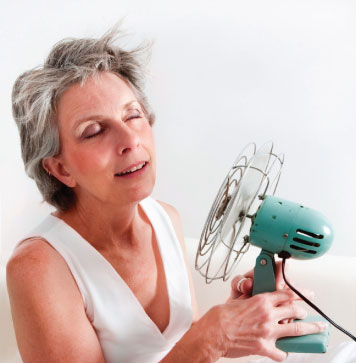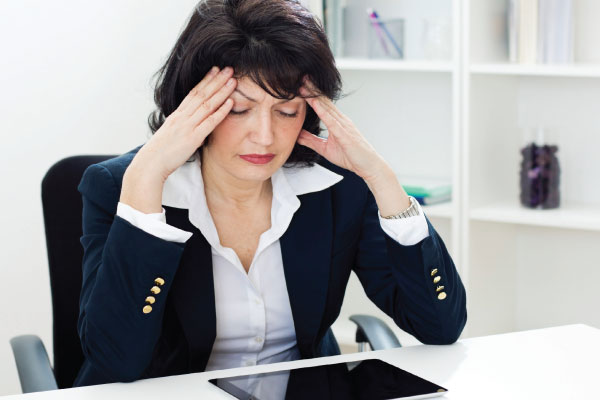WTM lets you in on the must-know of menopause, an inevitable phase of a woman’s life, to help you or a loved one survive it better.
Who hasn’t heard of the wrath and misery of a woman in menopause? The moodiness, the discomfort and those horrible hot flashes! No wonder someone said that a menopausal woman is a volcano threatening to erupt, except that sweat pours out instead of lava. Heed the experts to sail smoothly through these turbulent times.
The change before the change – perimenopause
Our expert: Dr Alka Gupta, obstetrician and gynaecologist at AMH
“Perimenopause means ‘around menopause’ and describes symptoms caused by normal hormonal fluctuations. It is the period during which a woman’s body makes its natural transition towards permanent infertility,” says Dr Alka.
The level of oestrogen – the main female hormone – rises and falls unevenly during perimenopause. Menstrual cycles may lengthen or shorten; ovulation may cease.
The most common effects of menopause include irregular and/or heavy bleeding, insomnia, night sweats and/or hot flashes, worsening PMS, migraine, vaginal dryness and abdominal weight gain on the physical front. On the emotional front, changing hormones are linked to increased bouts of anxiety, depression, irritability and intense mood swings.
Many women have experienced chest pain or palpitations from their hormonal imbalance. These symptoms differ for every woman, causing a lot of confusion, anxiety and frustration.
“Essentially the symptoms are similar to menopause, except that in the premenopausal phase a lady can still get pregnant,” the expert points out.
Sometimes, the effects of stress can be confused with perimenopause. For example, children leaving home, changes in relationships or careers, or the death or illness of parents can cause similar symptoms. On the other hand, genuine symptoms may be easy to brush off as PMS.
[quote]
It is just a phase of life that may need medical attention. However, it should not be considered an illness
[/quote]
A blood examination showing low oestrogen and progesterone levels and, as a result, a higher presence of FSH can be an indicator of whether a woman is in perimenopause, although this should not be the only measure for diagnosis. This transition begins several years before menopause. It usually starts in a woman’s forties, but can manifest in her thirties or even earlier.
“A woman may go in and out of a perimenopausal state for as many as 10 to 13 years before she arrives at true menopause; the average age of which is 52 years in the US. This means that it is perfectly natural for a woman as young as 40 to begin feeling foreign and seemingly inexplicable changes in her body and emotions,” says Dr Alka.
The real deal – Menopause
Our expert: Dr Farah Al Nuaimy, consultant, obstetrics and gynaecology at Bahrain Specialist Hospital
According to Dr Farah, women must consider menopause as a natural biological phenomenon. “It is just a phase of life that may need medical attention. However, it should not be considered an illness and it definitely doesn’t mean you have grown old,” says Dr Farah.
 Menopause doesn’t happen overnight. A woman is said to be in true menopause one whole year after her last menstruation. It marks the end of her menstrual cycles.
Menopause doesn’t happen overnight. A woman is said to be in true menopause one whole year after her last menstruation. It marks the end of her menstrual cycles.
“There are a lot of investigations to find out whether a woman is in perimenopause or actual menopause. The measurement of the hormones produced by the ovaries confirms whether one is really in menopause or not,” says Dr Farah.
Apart from the periods having ceased, the usual symptoms are hot flashes, unexplained headaches, mood swings and bloating. Dr Farah observes that the age when women attain menopause is steadily decreasing.
Earlier, menopause struck around the age of 50 to 55. Now women aged 45 to 48 start menopause. Gynaecologists and researchers expect this number to further decrease.
“The reason is mainly due to a combination of environmental and genetic changes. Our ovarian reserve is changing with subsequent generations. As we advance into the 22nd century, the age of menopause will further reduce,” says Dr Farah.
Certain treatments of illnesses bring on early menopause, like removal of ovaries, chemotherapy and radiotherapy. The sharp decline of female hormones in the body causes immediate symptoms like mood swings and hot flashes. They are temporary and can be helped. But the danger lies in the intermediate and late effects that menopause can bring about. They are permanent and cause a lot of harm.
Intermediate effects are infections of the genital and urinary tracts, and collagen laxity. Late symptoms include cardiac disease, Alzheimer’s and loss of bone density leading to osteoporosis.
“That is the reason researchers are concentrating more on preventing and treating these complications. There is a treatment for every problem arising out of menopause, which should be tailored to each individual,” says our expert.
Coping with menopause
Our expert: Dr Mangala Sundari, obstetrician and cosmetic gynaecologist at Ibn Al Nafees Hospital
Medical treatment is not necessary for all menopausal women. However, when symptoms are severe, treatment may be necessary to improve one’s wellbeing.
“Symptoms like vaginal dryness, urine incontinence and osteoporosis need to be treated,” says Dr Mangala.
Hormone replacement therapy (HRT) replaces the female hormones, which have decreased as the body reaches menopause. They are usually oestrogen, progesterone and sometimes testosterone and are available as tablets, pessaries, patches, implants or creams. HRT poses risk of breast cancer, heart diseases, stroke, and blood clots; hence it cannot be administered to patients with these risk factors or with liver disease. However, the therapy reduces the risk of developing osteoporosis, colon and rectal cancers, and is considered the most effective treatment of menopausal symptoms.
“HRT must start with low doses and be annually reviewed by the doctor. Long-term use and self-prescription must be avoided,” advises Dr Mangala.
Bio-identical hormone replacement therapy (BHRT) is nowadays widely used in the West to cope with menopause. Bio-identical hormones are made from a plant chemical extracted from yam and soy sources; their molecular structure is identical to the hormones found in the body. However, the US Food and Drug Administration states that bio-identical hormones are unsupported by medical evidence.
Dr Mangala endorses yoga to prevent osteoporosis and to improve mobility and muscle function. “Calcium supplements are also beneficial. Naturally occurring oestrogen such as phytoestrogens in cereals, legumes, vegetables, soya and yam can also help,” she says.





































